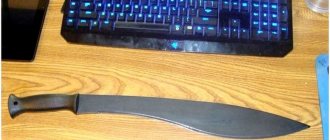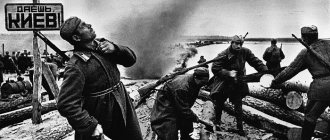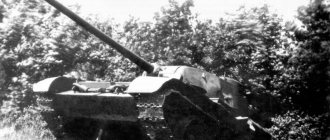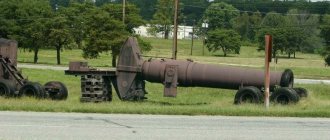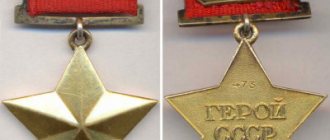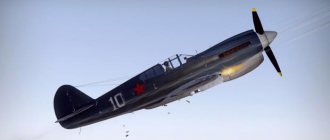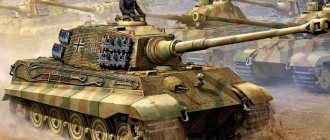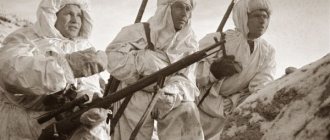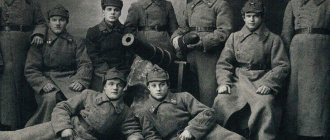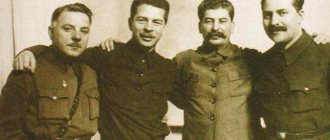Hello dear friends! Almost all of you know what a machete is. For those who don’t know, I’ll explain – this is a long knife with which blacks cut cane on plantations. On occasion, they could also cut down the planters, but that’s a completely different story. So, the most famous machete in Russia is the Tramontina. They are cheap, carbon steel, well-hardened. It’s just impossible to dig with them, and chopping wood is inconvenient.
But did you know that the best machetes for our forests were made in the USSR? It’s a shame to say, but nowadays foreigners know more about the famous special forces machete than our compatriots. Meet the Taiga-1 machete, developed by Skrylev.
Appearance
To begin with, it is worth noting the ergonomic handle - it provides a reliable grip - both forward and reverse.
The blade itself has a slightly elongated shape, with a slightly narrowed, predatory tip. There is a short file on the butt, which can be useful in difficult situations - you should never throw them off when going into the forest.
A rather complex pattern is etched on the blade - animals among a plant pattern with the obligatory letter “K” in the upper left corner - the sign of “Kizlyar”.
The handle consists of linings that are fixed to the blade with two reliable rivets. Therefore, there is no need to fear that the knife will break under strong pressure, as happens with cheaper analogues, where the shank is simply embedded in the handle and does not pass through it. Finally, there is a small hole in the tip of the knife. You can insert a narrow cord or a thin carabiner here to eliminate the possibility of losing an important tool when running or crossing through bushes or tall grass.
Review of the Gyurza knife
The tip of the blade is raised upward, and the butt has a significant upward bend. Due to such a well-developed rounding, the cutting part is characterized by elongation. As a standard, the blade has a design of a snake wrapped around a wooden branch. It is applied by etching followed by blackening. On the first blades the image was different.
The slopes of the knife have a slight concavity. The lower edge of the heel is molded with a deep semicircular choil (a special rest for the finger when gripping the center of gravity).
The tang and blade are solid; the plates that form the handle are secured using riveted pins. The handle has a curved back due to which the upper edge of the blade is wavy. The bolster expands towards the tip of the blade so that an annular support for the brush is formed.
On the bottom line of the knife there is a special recess for the finger. The line of the handle itself is concave inward; at its end there is a cut from which a twisted corner of the shank emerges. It has a hole for a lanyard. The handle has a flat and concave butt.
Purpose
The blade of the Gyurza-2 Kizlyar knife is curved, like the tooth of this poisonous snake; because of this shape, it is closer to the so-called skinners - skinning knives.
The Gyurza knife can have different purposes depending on its variety. For example, the Gyurza-2 is popular among hunters, having a specially curved blade for convenient butchering of animal carcasses in the field, and a handle made of non-slip material.
Materials used
The main material in the manufacture of the Kizlyar Taiga knife is AUS8 steel. A very successful alloy manufactured by a Japanese company. It has a number of important characteristics. Thus, steel has high corrosion resistance - even after leaving the knife in water for several days, the owner can be sure that rust will not appear on its surface. At the same time, it has a high degree of hardness, which allows you to sharpen the knife quite rarely even during intensive work. Finally, the blade is not afraid of accidental blows - the owner can be sure that chips will not appear on the cutting edge, as happens when working with knives made from too hard steel.
The handle is made of polished walnut. This wood is highly valued by knifemakers for its strength, durability, lightness and resistance to high humidity.
Features of the Multi-Tool
Taiga -1 has a long straight blade 212 mm long, the total length of the model with the handle is 347 mm, the width of the blade near the handle is 41 mm, and in the front part it is 80 mm. Thanks to this design, the blade can be used as a shovel.
The butt is straight, on it there is a saw with 14 teeth, with its help you can saw through ropes and small trees or branches. The handle is hollow, you can store NAZ elements in it.
This is such a wonderful thing, and you say Tramontina...
Main advantages
One of the most important advantages appreciated by both beginners and experienced knife lovers is high-quality sharpening. Indeed, the Taiga 2 knife boasts a precisely designed cutting edge. Even with very active work, you do not need to sharpen the knife often - the angle is well adjusted, so it is enough to just slightly correct it with ceramic or metal musat. Of course, this is much easier than sharpening a knife with a completely damaged cutting edge. This is ensured not only by sharpening on professional equipment, but also by using high-quality steel.
Another very important factor is the affordable price. Indeed, in most stores the price for a knife is set at a fairly low price - from 2 to 2.5 thousand rubles. Of course, for a good, reliable knife that won’t let you down in an extreme situation, this is a pretty low price.
The ergonomic handle has a special shape that eliminates the possibility of the hand slipping, both during normal work and during stabbing blows.
The butt is quite thick - 2.7 millimeters. Therefore, in a difficult situation, the knife can be used as a lever. It will also withstand chopping blows without harm, so it can be used not only for planing pegs, but also for chopping small branches.
What it is?
Scientifically, this thing is called UVSR. This abbreviation, scary at first glance, stands for “Device for performing rescue work.”
Lyrics aside, Taiga-1 is a wonderful tool, although I suspect that in the Soviet Union only one blank was produced, from which anything could be made, from a knife to an airplane. With its help you can chop, saw, dig and do a bunch of other useful things. Show me at least one modern knife that can handle all this! That's right, there are none! Even the famous small infantry shovel will not be able to cut trees, and it is not very convenient to cut with it, it does not have enough weight and the metal is too thin.
Purpose
When purchasing a Taiga knife from Kizlyar, it is worth considering that it is a bladed weapon. That is, you won’t be able to simply go to a tourist or hunting store and buy it. It is necessary to complete the appropriate documents to obtain permission to purchase, store and carry it. The corresponding mark must also be placed on the hunting license, which the owner of the knife must always have with him when leaving home with this knife.
However, any additional hassle associated with paperwork for purchasing a knife is fully compensated by its reliability and ease of use. After all, the Taiga knife is a truly multifunctional tool that can be used to cut, plane, chop, stab, and, if necessary, saw. So, if you value reliable things that won’t let you down in an extreme situation, you definitely won’t regret this choice.
Knife Kizlyar Sterkh 3
Good afternoon. I present to you a universal tourist knife from the Kizlyar
—
Siberian Crane 3
.
was founded in 1998.
Engaged in the production of civilian bladed weapons, household knives and souvenir weapons. ___________________________________________
Knife characteristics:
Total length - 294 mm Blade length - 170 mm Blade thickness along the spine - 3.6 mm Blade width - 31 mm Blade material - 65X13 steel Blade hardness on the Rockwell scale - 56-58 HRC Handle material - Elastron G Handle thickness - 22 mm Knife weight - 220 gr.
Includes a belt sheath made of genuine leather. The weight of the knife with sheath is 294 g.
A small digression. It is simply necessary here, unfortunately.
* * * Dear reader! This knife is not a bladed weapon
, which is confirmed by the corresponding certificate.
(see below) I do not use this knife for self-defense, nor for attacking people or animals. I paid exactly what the seller asked for this knife. I chose this knife based on a combination of various technical factors, market selection, price and my personal criteria. I don't carry it with me all the time. Its size, weight and shape suit me. I didn't do any specific tests with the knife. The knife is used for household purposes. I hope for your understanding and tact. Thank you. * * * As we can see, the knife is quite large. In the sheath, the knife is secured with a strap on a rivet. Quite a convenient and durable option. The fixing strap is located on the upper belt loop, of which there are two.
In the unfastened position, the securing strap with the top loop can be folded back.
This will allow you to easily remove the knife and put it back into the sheath. For example, when doing work and there is no place where you can simply put the knife.
The impressive length of the blade and cutting edge makes it easy to cut large objects. Whether it’s a loaf of bread, a watermelon or a piece of meat, you don’t have to move the knife around in a circle, resting against the handle. A not too thick butt makes cutting with a knife more comfortable, unlike thick “cleavers”.
The blade has inscriptions. On the one hand - KIZLYAR.
Made in Russia. HRC 57-59 (here we mean units on the Rockwell scale)
On the other hand, Sterkh 3 is the name of the knife model and the image of the Kizlyar logo.
What is Sterkh?
The Siberian Crane, or white crane (lat. Grus leucogeranus) is a species of crane endemic to the northern territories of Russia.
The steel used in the manufacture of this blade is 65X13 - one of the popular materials for the manufacture of blades (foreign analogue 420J or 425mod).
A little about steel 65X13
Its original purpose is a cutting tool, kitchen knives, saws, removable blades, scalpels, razor blades. Since scalpels and other medical instruments are often made from it, it is also often called “medical”. It was developed a long time ago and, they say, no longer fully meets modern requirements for knife products. However, this is an inexpensive stainless steel that does not require serious maintenance, is relatively easy to sharpen and holds an edge well. Overall, it’s not a bad option for an inexpensive working knife. With proper heat treatment, it has a hardness of 56-58 HRC. When properly sharpened, the blade has good cutting properties and wear resistance.
The handle of this knife is made of material - Elastron G. Quite durable and tenacious thermoplastic elastomer based on SEBS, a trademark of a family of compounds based on the styrene block copolymer SEBS (styrene-ethylene-butylene-styrene) and polyolefins, which have the properties of rubber and have the advantage of processing thermoplastics . Nicely written, right? XD Here in more or less human language ↓
A little about the advantages of Elastron G
• Hardness like vulcanized rubber and does not require vulcanization • Remains flexible at temperatures from -40° to 130°C • 100% recyclable • Excellent detergent resistance • There is a group of grades with high combustion resistance • High strength tensile strength, up to 100 kN/m • Excellent resistance to most acids and bases • There is a group of grades with very low permanent deformation • There is a group of grades with high abrasion resistance • High resistance to bacteria and fungi • High resistance to degradation at elevated temperatures • Excellent electrical insulator, with very low conductivity • High resistance to ozone, ultraviolet light, oxidation, weathering and aging • Can be painted during processing using polypropylene or polyethylene based masterbatch
The handle is comfortable, long enough, with a thickening at the end. Does not lose its adhesion properties in water or in the cold. There is a hole for a lanyard with a pressed and flared tube. The thickening at the end of the handle allows you to comfortably hold the knife when chopping. With a lanyard on your wrist, the chances of “throwing away” the knife from a tired hand are extremely small.
There is nothing on the end of the handle. In principle, cullets and other varieties are not needed here.
With this geometry, the grip can be very different. Basically, like this, of course:
For comparison with EDC - Spyderco Paramilitary2.
And with a burned-out Victorinox living in the car
Sterkh 3 is also available with a polished blade, without any color coating, as well as with a wooden handle (walnut dies).
Certificate:
My opinion: Sterkh 3 is an excellent and inexpensive camping knife. Holds an edge tolerably well. If necessary, it can be straightened “on the knee”; it does not require particularly tough abrasives or devices. The blade coating is quite durable. After a couple of years of use, of course, abrasions and scratches are visible, but this is a working knife, not a shelf holder. The sheath is comfortable and reliable. It would be possible to provide a hole at the bottom to allow the sheath to be fixed on the thigh, but these are just my guesses and in general the issue is controversial, due to the dimensions of the knife. I have never worn knives on my hip, but I admit the possibility.
Thank you for your attention.
Features of the scabbard
An integral part of any knife is the sheath. After all, it depends on them how comfortable it will be to carry a knife, whether there is a high risk of losing the tool in a difficult situation, whether there is a possibility of injuring yourself during work.
The developers took into account all these nuances and tried to produce a truly high-quality, reliable and simple sheath.
Like most products in the mid-price segment from Kizlyar, Taiga hunting knives are equipped with leather sheaths. They are durable, reliable, do not fade over time and are not afraid of moisture. At the same time they look great.
They are equipped with a special button - because of it, it takes half a second more time to remove the knife, but the risk of losing it is completely eliminated. You can run, hang upside down, jump - be sure that the knife will not fall out.
How to use Gyurza?
The Gyurza folding tourist knife is suitable for performing any household or field work.
For soldiers of law enforcement agencies, this issue is not relevant, since they undergo special training. But if we talk about the Gyurza tourist folding knife, then everything depends on the chosen model. The knife must be used taking into account the bend of the blade and its attachment to the handle. An ordinary tourist Gyurza is suitable for performing household or field work, be it cutting meat or vegetables, sharpening pegs, organizing a fireplace, etc.
The hunting Gyurza will perfectly cope with the tasks assigned to the hunter: skinning animals, gutting, etc.
